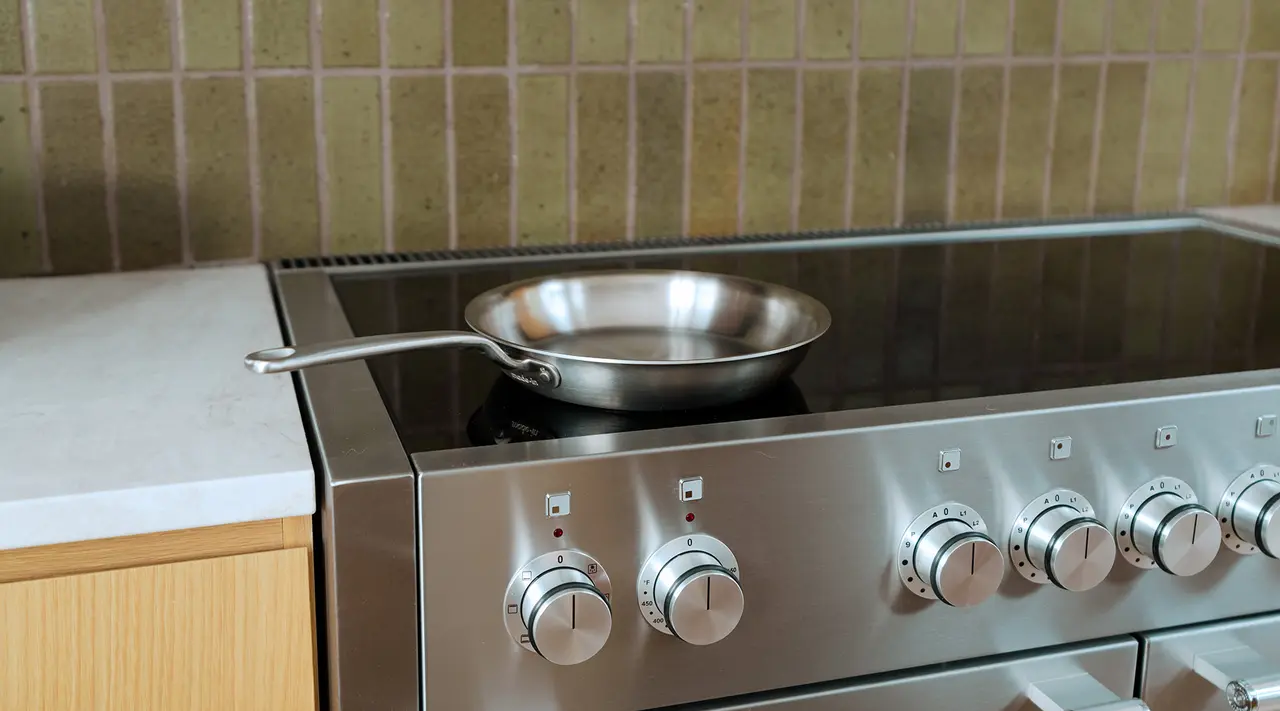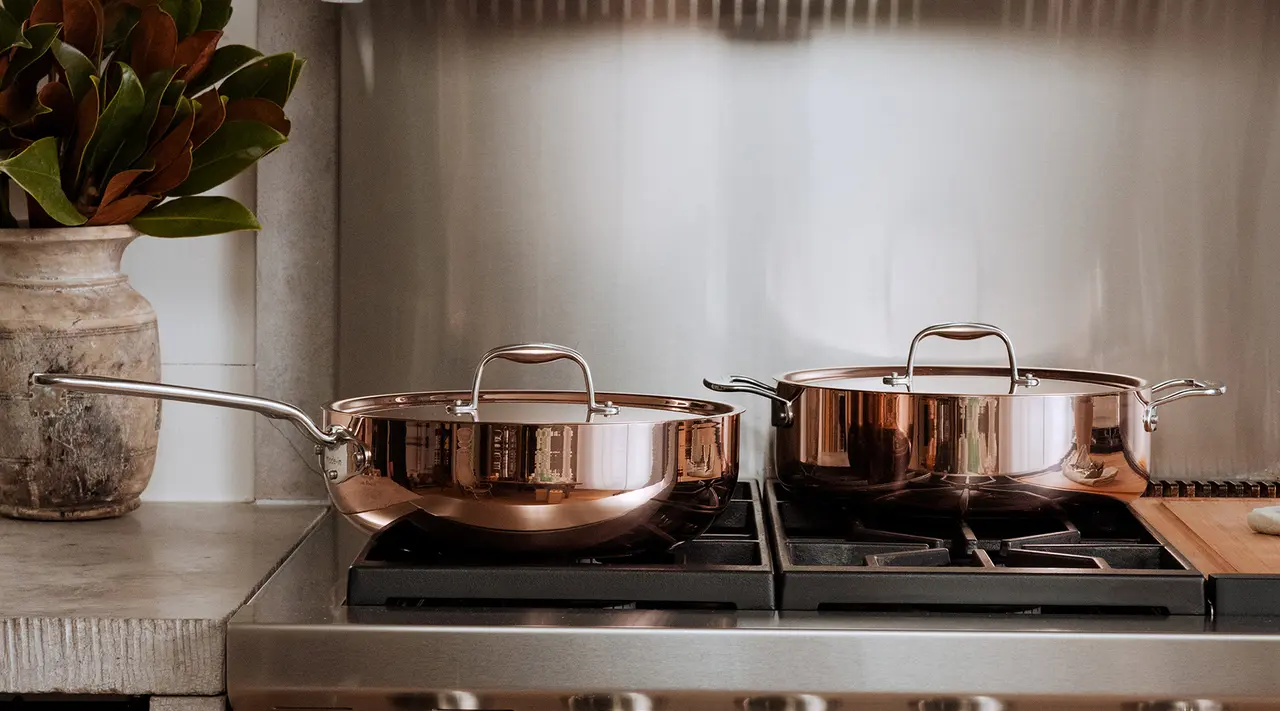If you have an induction stove, you’re likely used to double- and even triple-checking that your cookware is, in fact, induction compatible. Due to the specific nature of the induction cooking process, only certain types of cookware materials work on these stovetops—which makes ensuring induction compatibility even more important.
Here, we’ll go over what induction compatibility means and what the best type of cookware is for these types of stovetops.
How Does Induction Cooking Work?

Unlike a standard gas or electric range, which uses thermal conduction like flames or an electric burner, an induction stove uses electromagnetism to transfer heat. Inside an induction burner, electricity runs through a copper coil and creates an electromagnetic field that creates heat—the same technology used to power radios and microwaves.
Alone, this electromagnetic field does nothing. When paired with induction compatible cookware, the electromagnetism excites the molecules in your pan and transfers heat energy from the stovetop to the pan and, finally, to your food. This means that anything placed on an induction burner (hands, utensils, or errant ingredients) that aren't ferromagnetic will not get hot.
Because induction cooking requires electromagnetism, only pans made from a magnetic metal, otherwise known as ferromagnetic cookware, are compatible for induction cooking.
Here’s the takeaway: to cook on an induction cooktop you’ll need induction-compatible cookware.
What Cookware Is Induction Compatible?

Only certain types of cookware materials will work on induction cooktops. Iron or magnetic stainless steel needs to be in the core of your cookware in order for it to be induction compatible.
The following materials are commonly induction compatible, but check with the manufacturer to be sure. Most induction compatible cookware will explicitly state that, or be denoted with a coil symbol.
- Carbon steel
- Cast iron (both enameled and unfinished)
- Ceramic
- Non stick
- Stainless steel
Induction compatibility varies across manufacturer, price, and construction quality of your cookware. This is why it’s important to do your research before purchasing pans for an induction cooktop—even the highest-price, most well-reviewed set of cookware may not be induction compatible.
How to Test Cookware for Induction Compatibility
To easily test your cookware for induction compatibility, all you need is a standard refrigerator magnet. Flip your pot or pan over and place a magnet on the bottom. If your cookware is induction compatible, then the magnet will either be repelled or attracted to your pan—either way, you’ll feel a strong reaction.
If your pan isn’t induction compatible, you won’t feel any interaction between the magnet and your cookware. Test this with a stainless steel frying pan (which should be induction compatible) vs. a plate (not induction compatible).
What’s the Best Cookware for Induction Cooking?

Just like choosing a favorite for cooking on electric or gas stoves, the answer for the best cookware for induction stoves depends on a few factors. Here are our favorites depending on your preference and what you may be looking for.
Most Versatile: Stainless Clad
Generally, stainless steel is going to be a safe, versatile bet that 9 times out of 10 will boast induction compatibility.
Our Stainless Clad Cookware is made of 5-ply, fully induction-compatible 18/10 stainless steel, which is a much better and longer-lasting option than cheaper aluminum pans (which are more prone to warping and have shorter lifespans).
Most Heavy-Duty: Carbon Steel
For high-heat, heavy-duty cooking, our go-to is our Carbon Steel. Lightweight enough for maneuvering around the stovetop but durable enough for steak night, Carbon Steel is induction-compatible and ready to cook on any surface, from induction to the grill.
Easiest Clean Up: ProCoat Non Stick
Using non stick on induction can get tricky, as certain types of non stick pans are compatible while others aren't—all depending on the materials used to construct the pans.
Luckily, our ProCoat Non Stick is fully induction-compatible—unlike other ceramic or non stick options with a cheaply welded-on induction plate on the bottom. Our ProCoat line is trusted by professional chefs and home cooks alike for their ability to hold up on induction stoves and even in and out of the oven.
What Cookware Is Not Incompatible with Induction?

That said, there are other types of cookware materials that won’t work with induction cooktops. Copper cookware and pans with aluminum or non-magnetic stainless steel cores can’t interact with the electric field of an induction burner, as they are not ferromagnetic and cannot produce a concentrated magnetic current.
While they may technically be induction compatible, we recommend avoiding pans that are not wholly induction compatible and instead feature a pasted-on induction plate on the bottom of the pan. This is a likely indicator that the pan is not made of induction compatible materials—and while this will generate heat on an induction cooktop, it will only be heated on the bottom and not up the sides. This results in a far inferior cooking experience on induction stoves than a pan not only compatible with induction, but optimized for it.
Ready to Cook?
If you've made the switch to induction, there's no reason to fret about your cookware not being compatible—nowadays, most types of cookware are engineered for induction.
If you do in fact need to get induction-compatible pans or are on the market for ones that perform exceptionally no matter the stovetop, our collections of ProCoat Non Stick, Stainless Clad, Carbon Steel, and Enameled Cast Iron are both induction compatible and ready to be put to work on your induction stovetop.

































